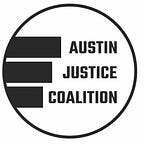AJC’s Letter in Response to the 2nd Reading of the New Land Development Code.
The Austin Justice Coalition’s Complete Communities Initiative aims to continually listen to residents in communities most impacted by segregation and displacement, with the goal of equipping them with tools needed to engage in ongoing conversations regarding housing, community development, and environment sustainability. We continue to believe the new Land Development Code provides a key avenue to bring all residents into the conversation on the legacy of segregation and how we, as a collective, can begin to unravel the policies that have created a divided city.
When we entered this conversation, we understood that it would not be enough to protect vulnerable areas, even as we understood that an unqualified call for density would not move us closer to truly addressing our housing challenges. We want to bring a strong emphasis on anti-displacement and right to return into the definition of a Complete Community. So, while we still do not see the new Land Development Code as a solution to all the housing inequities in Austin, we do seek an equitable approach to density — densification with an awareness of historic injustice, and a desire not to repeat historic mistakes. By bolstering economic and racial equity for people of color in Austin, with a special emphasis on housing and community development, all residents can have access to opportunity across the city.
We appreciate the thoughtful engagement we have had with council and city staff on the LDC, Draft 1 and Draft 2.
Below are, what we believe to be some of the strong points in Darft 2, as well as some of our major concerns.
We appreciate the changes that have been made to Draft 2 of the LDC that help minimize the displacement of working class people and residents of color. Such changes are:
- The inclusion of provisions of the Equity Overlay, outlined by Mayor Pro Tem Garza, which include:
a. The elimination or reduction in transition zones in “Susceptible”, “Early — Type 1” and “Dynamic” areas, according to the UT Uprooted Study, in order to minimize displacement of current residents and people of color.
b. Includes the “Equity Area Affordable Housing Bonus Program,” that sets a higher requirement for on-site affordable units and disincentives the redevelopment of existing multifamily housing.
c. Provides a right to return requirement for existing tenants if the existing multifamily is redeveloped.
2. The inclusion of source of income protection for tenants and the city’s right to subsidize all units in a development if a developer participates in the city’s affordable housing bonus program.
3. Revises the Preservation Program to allow residents to stay in place while providing opportunities for the creation of more homes and residents access to existing community benefits.
4. The incorporation of Garza’s amendment re: Small Neighborhood Grocers as well as additional small commercial allowed in the residential zones to establish walkable corridors of equitable opportunity across the city to mirror corridors like West Lynn and 51st Street at Duval Street.
5. The increase in housing capacity, including opportunities for affordable housing, in high opportunity areas, particularly along the following corridors: Spicewood Springs, Enfield Road, and Jollyville Road.
While Draft 2 gets us closer to accomplishing the a more equitable, just code, there are a few key crucial points that believe are still worth addressing at this stage, and we ask for consideration of the following recommendations for Draft 3 of the LDC.
- Extend the provisions of the equity overlay to the rest of the city re: mapping of existing multifamily to current use and allow for the right to return for current tenants for multifamily redevelopment.
- We continue to seek an equitable expansion of housing capacity, including spaces for affordable housing in high opportunity areas in corridors, such as Exposition Blvd., Winsor Road, Justin Lane.
- Apply tenant protections uniformly across all city funded or incentive programs to provide consistency and ease for both developers and renters.
- By preserving Neighborhood Combining Conservation Districts (NCCDs) under F25 in the LDC we will solidify a pattern of exclusionary zoning and move towards a future that still permits certain neighborhoods to retain special status, which makes it more difficult to plan the city equitably and consistently. We recommend allowing for the possibility of future revision of the F25 zoning category and a sunset clause for F25.
- We strongly support ACBA’s revision of the Co-Housing and Group Housing definitions to allow 2 to unrelated persons per sleeping unit as well as allow Group Residential by CUP in all residential zones.
We appreciate the city’s receptiveness to listening to working class and residents of color. To have an economic and culturally diverse city, we need a land development code that seeks to meet that goal. We thank you for your leadership in continually striving to address the affordable housing needs of the city and being cognizant of the displacement pressures current residents face every day. Continually looking with a racial and economic justice lens when seeking changes to policy and programming is required to create the equitable, just city we envision.
